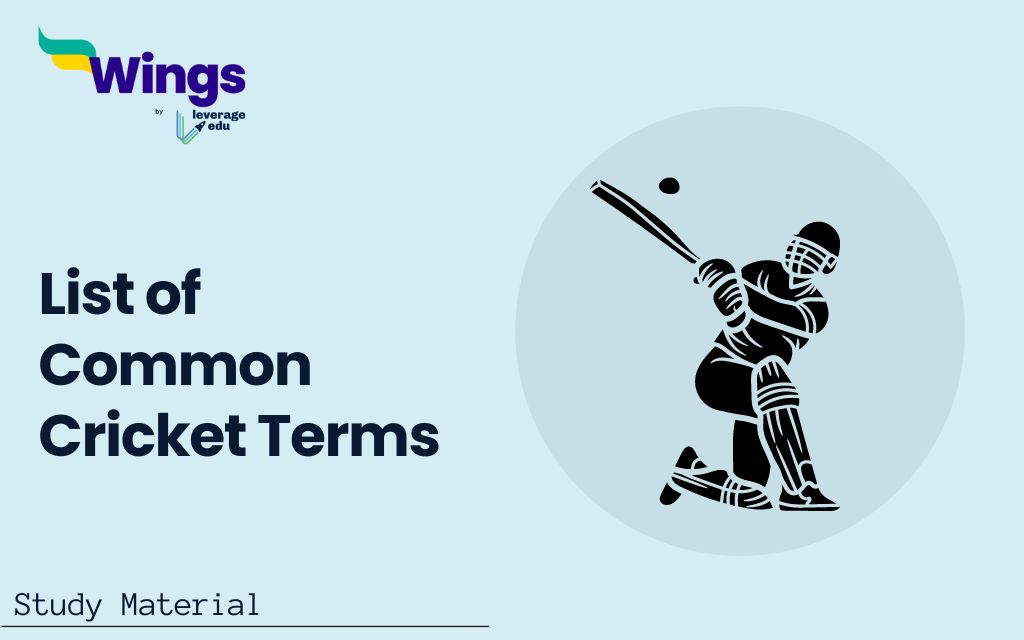Ever find yourself watching a cricket match, captivated by the action but confused by the commentary? Or maybe you’re an exam aspirant in Government Exams AFCAT, CDS, NDA facing questions about the sports? This blog post is your one-stop guide to understanding the language of cricket. We’ll go over the most important common Cricket terms, from the basic terms that make up the game to the more complex words that experienced fans and experts use. If you’re new to cricket or just want to do well on your Govt. Exams, this complete guide will help you feel confident in the exciting world of cricket.
Contents
The Playing Field
- Pitch: The central rectangular area where the bowler runs and bowls the ball.
- Wicket: Three wooden stumps topped by two bails, positioned at each end of the pitch. Dismissing a batsman involves dislodging the bails.
- Crease: A marked line on the pitch. Important creases include the popping crease (batsman’s front foot position) and the bowling crease (bowler’s delivery point).
- Boundary: The perimeter of the playing field. Hitting the ball over the boundary scores six runs, while reaching it on the ground scores four.
Also Read: The Essential Guide to Course of Action Reasoning
The Players
- Batsman/Batter: The player wielding the bat, trying to score runs and avoid dismissal.
- Bowler: The player who throws (bowls) the cricket ball toward the batsman.
- Fielder: Players positioned around the field who try to catch the ball hit by the batsman and run out batsmen.
- Wicket-keeper: A specialized fielder positioned behind the batsman, responsible for catching balls and collecting throws near the wicket.
Scoring Runs
- Run: The fundamental unit of scoring. Batsmen run between the wickets to earn runs.
- Single/Double/Triple: Running one, two, or three times between the wickets, respectively.
- Four: Hitting the ball to the boundary and running four times before it reaches the fielders.
- Six: Hitting the ball cleanly over the boundary for six runs.
- Overthrow: When the fielder throws the ball past the intended target (usually the wicket-keeper), awarding runs to the batting team.
Dismissals
- Caught: A fielder catches the ball before it bounces after the batsman hits it.
- Bowled: The bowler hits the wicket with the ball, dislodging the bails.
- LBW (Leg Before Wicket): The batsman obstructs the ball with their leg when it would have hit the wicket.
- Run Out: A fielder throws the ball at the wicket before the batsman reaches the crease.
- Stumped: The wicket-keeper dislodges the bails with the ball in their gloves while the batsman is out of their crease.
Match Formats
- Test Match: The longest format, played over five days. Each team gets two innings to bat, with a set number of overs bowled each day.
- ODI (One Day International): A limited-overs format, each team batting for 50 overs.
- T20 (Twenty20): A fast-paced format, each team batting for 20 overs.
Bowling Techniques
- Pace Bowling: Bowling with high speed, relying on the ball’s pace to beat the batsman.
- Spin Bowling: A bowling technique where the ball is delivered with a twist for movement, deceiving the batsman. Common deliveries include:
- Off-spin: The ball spins away from the batsman (for a right-handed bowler).
- Leg-spin: The ball spins towards the batsman (for a right-handed bowler).
- Googly: A disguised leg-spin delivery delivered like an off-spin.
Also Read: Which Type Question is Easiest in an Exam?
Advanced Terms
- Appeal: The fielding side requests the umpire to declare a batsman out.
- No Ball/Wide: An illegal delivery by the bowler, awarding runs to the batting team.
- Off-side/Leg-side: The two halves of the cricket field are divided by the batsman’s stance.
- Doosra: An off-spin bowler’s delivery that spins away from a right-handed batsman like a leg-spin.
- Chinaman: A leg-spin bowler’s delivery that spins into a right-handed batsman like an off-spin.
- Duck: Scoring zero runs in an inning.
Understanding these terms will strengthen your performance in exams that might include cricket questions. This list provides a strong foundation for your cricketing vocabulary. As you delve deeper, explore terms like “s Yorker,” a fastball delivered at the batsman’s feet, or “DRS (Decision Review System),” the technology used to review umpiring decisions.
FAQs
5 most common sports are football, baseball, basketball, ice hockey, and soccer.
There are tennis courts, badminton courts, basketball courts, cricket grounds, and football grounds in every cantonment for officers to use. In their free time, these sites let officers play their favorite sports, and if they are in professional Air Force sports, they can even improve their skills.
The NDA has a great set of facilities for training cadets in all areas. These include large, well-kept classrooms, well-equipped labs, three Olympic-sized swimming pools, gyms, 32 football fields, two polo grounds, a cricket stadium, and many squash and tennis courts.
RELATED BLOGS
This was all about the “List of Common Cricket Terms”. For more such informative blogs, check out our Study Material Section, or you can learn more about us by visiting our Indian exams page.
 One app for all your study abroad needs
One app for all your study abroad needs














